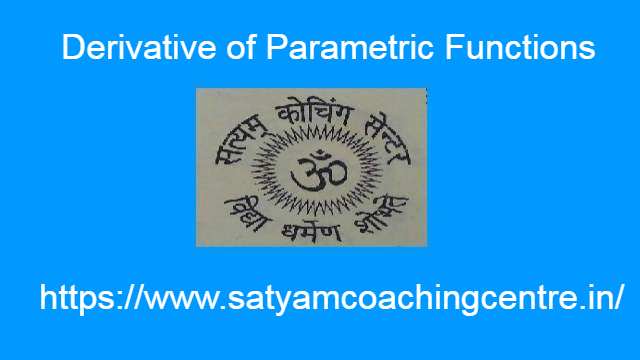Derivative of Parametric Function
1.फलनों के प्राचलिक रूपों के अवकलज (Derivative of Parametric Function),प्राचलिक अवकलन कक्षा 12 (Parametric Differentiation Class 12):
फलनों के प्राचलिक रूपों के अवकलज (Derivative of Parametric Function) तब ज्ञात किए जाते हैं जब दी गई प्राचलिक समीकरण से प्राचल का विलोपन कठिन हो।यदि चरों x तथा y दोनों किसी अन्य चरों (जैसे t के पदों में) में व्यक्त किए जाते हैं तब उस चर राशि (जैसे t) को प्राचल कहते हैं।
कैलकुलस में, एक पैरामेट्रिक अवकलज एक आश्रित चर का एक आश्रित चर के सापेक्ष अवकलज होता है जिसे तब लिया जाता है जब दोनों चर एक स्वतंत्र तीसरे चर पर निर्भर करते हैं, जिसे आमतौर पर “समय” के रूप में माना जाता है (अर्थात् जब आश्रित चर x और y, स्वतन्त्र चर t में पैरामेट्रिक समीकरणों द्वारा दिए गए हैं)।
जैसे-x=f(t),y=\phi(t)
तब \frac{d y}{d x}=\frac{\frac{dy}{dt}}{\frac{dx}{dt}} जहाँ \frac{dx}{dt} \neq 0
आपको यह जानकारी रोचक व ज्ञानवर्धक लगे तो अपने मित्रों के साथ इस गणित के आर्टिकल को शेयर करें।यदि आप इस वेबसाइट पर पहली बार आए हैं तो वेबसाइट को फॉलो करें और ईमेल सब्सक्रिप्शन को भी फॉलो करें।जिससे नए आर्टिकल का नोटिफिकेशन आपको मिल सके ।यदि आर्टिकल पसन्द आए तो अपने मित्रों के साथ शेयर और लाईक करें जिससे वे भी लाभ उठाए ।आपकी कोई समस्या हो या कोई सुझाव देना चाहते हैं तो कमेंट करके बताएं।इस आर्टिकल को पूरा पढ़ें।
Also Read This Article:-Inverse Trigonometric Functions
2.फलनों के प्राचलिक रूपों के अवकलज के उदाहरण (Derivative of Parametric Functions Example),प्राचलिक अवकलन की समस्याएं और हल (Parametric Differentiation Problems and Solutions):
\frac{d y}{d x} ज्ञात कीजिए जबकि
Example-1.x=a \sec t, y=b \tan t
Solution-x=a \sec t, y=b \tan t
t के सापेक्ष अवकलन करने पर-
\frac{d x}{d t} =a \sec t \tan t, \frac{d y}{d t}=b \sec ^{2} t \\ \Rightarrow \frac{d y}{d x} =\frac{\frac{dy}{dt}}{\frac{dx}{dt}} \\ =\frac{b \sec^{2} t}{a \sec t \tan t} \\ =\frac{b \sec t}{a \tan t} \\ =\frac{\frac{b}{\cos t}}{\frac{a \sin t}{\cos t}} \\ =\frac{b}{a \sin t} \\ \Rightarrow \frac{d y}{d x}=\frac{b}{a} \operatorname{cosec} t
Example-2.x=\log t+\sin t, y=e^{t}+\cos t
Solution–x=\log t+\sin t, y=e^{t}+\cos t
t के सापेक्ष अवकलन करने पर-
\frac{d x}{d t}=\frac{1}{t} + \cos t, \frac{d y}{d t}=e^{t}-\sin t \\ \Rightarrow \frac{d x}{d t}=\frac{1+t \cos t}{t} \\ \Rightarrow \frac{d y}{d x}=\frac{\frac{dy}{dt}}{\frac{dx}{dt}} \\ =\frac{e^{t}-\sin t}{\frac{1+t \cos t}{t}} \\ \Rightarrow \frac{d y}{d x}=\frac{t\left(e^{t}-\sin t\right)}{1+\cos t}
Example-3.x=\log t, y=e^{t}+\cos t
Solution-x=\log t, y=e^{t}+\cos t
t के सापेक्ष अवकलन करने पर-
\frac{d x}{d t}=\frac{1}{t}, \frac{d y}{d t}=e^{t}-\sin t \\ \Rightarrow \frac{d y}{d x}=\frac{\frac{d y}{d t}}{\frac{d x}{d t}} \\ =\frac{e^{t}-\sin t}{\frac{1}{t}} \\ \Rightarrow \frac{d y}{d x}=t\left(e^{t}-\sin t\right)
Example-4.x=a \cos \theta, y=b \sin \theta
Solution-x=a \cos \theta, y=b \sin \theta
\theta के सापेक्ष अवकलन करने पर-
\frac{d x}{d \theta}=-\operatorname{asin} \theta, \frac{d y}{d t}=b \cos \theta \\ \Rightarrow \frac{d y}{d x} =\frac{\frac{d y}{d \theta}}{\frac{d x}{d \theta}} \\ =\frac{b \cos \theta}{-a \sin \theta} \\ \Rightarrow \frac{d y}{d x} =-\frac{b}{a} \cot \theta
Example-5.x=\cos \theta-\cos 2 \theta, y=\sin \theta-\sin 2 \theta
Solution-x=\cos \theta-\cos 2 \theta, y=\sin \theta-\sin 2 \theta
\theta के सापेक्ष अवकलन करने पर-
\frac{d x}{d \theta}=-\sin \theta+2 \sin 2 \theta \\ \Rightarrow \frac{d y}{d \theta}=\cos \theta-2 \cos 2 \theta \\ \Rightarrow \frac{d y}{d x}=\frac{\frac{d y}{d \theta}}{\frac{d x}{d \theta}} \\ =\frac{\cos \theta-2 \cos 2 \theta}{-\sin \theta+2 \sin 2 \theta} \\ \Rightarrow \frac{d y}{d x}=\frac{\cos \theta-2 \cos 2 \theta}{2 \sin 2 \theta-\sin \theta}
Example-6.x=\theta-\sin \theta, y=a(1+\cos \theta)
Solution-x=\theta-\sin \theta, y=a(1+\cos \theta)
\theta के सापेक्ष अवकलन करने पर-
\frac{d x}{d \theta}= 1-cos \theta ,\quad \frac{d y}{d \theta}=-a \sin \theta \\ \Rightarrow \frac{d y}{d x} =\frac{\frac{d y}{d \theta}}{\frac{d x}{d \theta}} \\ =\frac{-a \sin \theta}{1-\cos \theta} \\ =\frac{-2 a \sin \frac{\theta}{2} \cos \frac{\theta}{2}}{1-\left(1-2 \sin ^{2} \frac{\theta}{2}\right)} \\ =\frac{-2 a \sin \frac{\theta}{2} \cos \frac{\theta}{2}}{1-1+2 \sin ^{2} \frac{\theta}{2}} \\ \Rightarrow \frac{d y}{d x}=\frac{-2 a \sin \frac{\theta}{2} \cos \frac{\theta}{2}}{2 \sin ^{2} \frac{\theta}{2}} \\ \Rightarrow \frac{d y}{d x}=-a \cot \frac{\theta}{2}
Example-7.x=\sqrt{\sin 2 \theta}, \quad y=\sqrt{\cos 2 \theta}
Solution–x=\sqrt{\sin 2 \theta}, \quad y=\sqrt{\cos 2 \theta}
\theta के सापेक्ष अवकलन करने पर-
\frac{d x}{d \theta}=\frac{2 \cos 2 \theta}{2 \sqrt{\sin 2 \theta}}, \frac{d y}{d \theta}=-\frac{2 \sin 2 \theta}{2 \sqrt{\cos 2 \theta}} \\ \Rightarrow \frac{d x}{d \theta}=\frac{\cos 2 \theta}{\sqrt{\sin 2 \theta}} , \frac{d y}{d \theta}=-\frac{\sin 2 \theta}{\sqrt{\cos 2 \theta}} \\ \Rightarrow \frac{d y}{d x}=\frac{ \frac{d y}{d \theta} }{\frac{d x}{d \theta}} \\ =\frac{-\frac{\sin 2 \theta}{\sqrt{\cos 2 \theta}}}{ {\frac{\cos 2 \theta}{\sqrt{\sin 2 \theta}}}} \\ =-\left(\frac{\sin 2 \theta}{\cos 2 \theta}\right)^{\frac{3}{2}} \\ \Rightarrow \frac{d y}{d x}=-(\tan 2 \theta)^{\frac{3}{2}}
Example-8.x=a \cos ^{3} t, y=a \sin ^{3} t
Solution-x=a \cos ^{3} t, y=a \sin ^{3} t
t के सापेक्ष अवकलन करने पर-
\frac{d x}{d t}=-3 a \cos ^{2} t \sin t \\ \frac{d y}{d t}=3 a \sin ^{2} t \cos t \\ \frac{d y}{d x}=\frac{\frac{dy}{dt}}{\frac{dx}{dt}} \\ =\frac{3 a \sin ^{2} t \cos t}{-3 a \cos ^{2} t \sin t} \\=-\frac{\sin t}{\cos t} \\ \Rightarrow \frac{d y}{dx} =-\tan t
Example-9.x=e^{\theta}\left(\theta+\frac{1}{\theta}\right), y=\bar{e}^{\theta}\left(\theta-\frac{1}{\theta}\right)
Solution–x=e^{\theta}\left(\theta+\frac{1}{\theta}\right), y=\bar{e}^{\theta}\left(\theta-\frac{1}{\theta}\right)
\theta के सापेक्ष अवकलन करने पर-
\frac{d x}{d \theta} =e^{\theta}\left(\theta+\frac{1}{\theta}\right)+e^{\theta}\left(1-\frac{1}{\theta^{2}}\right) \\ =e^{\theta}\left[\theta+ \frac{1}{\theta}+1-\frac{1}{\theta^{2}}\right] \\ =e^{\theta}\left[\frac{\theta^{3} +\theta+ \theta^{2}-1}{\theta^{2}}\right] \\ \Rightarrow \frac{d x}{d \theta} =\frac{e^{\theta}\left(\theta^{3}+\theta^{2} +\theta-1\right)}{\theta^{2}} \\ \frac{d y}{d \theta} =-e^{-\theta}\left(\theta-\frac{1}{\theta}\right)+e^{-\theta}\left(1+\frac{1}{\theta^{2}}\right) \\ =e^{-\theta}\left[-\theta+\frac{1}{\theta}+1+\frac{1}{\theta^{2}}\right] \\ =e^{-\theta}\left[\frac{-\theta^{3}+\theta+ \theta^{2} +1}{\theta^{2}}\right] \\ \Rightarrow \frac{d y}{d \theta} =\frac{e^{\theta}\left(-\theta^{3} +\theta+\theta^{2}+1\right)}{\theta^{2}} \\ \Rightarrow \frac{d y}{d x} =\frac{\frac{d y}{d \theta}}{\frac{d x}{d \theta}} \\ =\frac{\bar{e}^{\theta}\left(-\theta^{3}+\theta^{2}+\theta+1\right)}{\theta^{2}} \times \frac{\theta^{2}}{e^{\theta} \left(\theta^{3}+\theta^{2}+\theta-1\right)} \\ \Rightarrow \frac{dy}{dx}=\frac{ e^{-2 \theta}\left(-\theta^{3}+ \theta^{2}+\theta+1\right)}{\left(\theta^{3}+\theta^{2}+\theta-1\right)}
Example-10.x=\frac{3 a t}{1+t^{3}}, y=\frac{3 a t^{2}}{1+t^{3}}
Solution-x=\frac{3 a t}{1+t^{3}}, y=\frac{3 a t^{2}}{1+t^{3}}
t के सापेक्ष अवकलन करने पर-
\frac{d x}{d t}=\frac{3 a\left[\left(1+t^{3}\right) \cdot 1-t \cdot 3 t^{2}\right]}{\left(1+t^{3}\right)^{2}} \\ \Rightarrow \frac{d x}{d t}=\frac{3 a\left(1+t^{3}-3 t^{3}\right)}{\left(1+t^{3}\right)^{2}} \\ \Rightarrow \frac{d x}{d t}=\frac{3 a\left(1-2 t^{3}\right)}{\left(1+t^{3}\right)^{2}} \\ \frac{d y}{d t}=\frac{3 a\left[\left(1+t^{3}\right) \cdot 2 t-t^{2} \cdot 3 t^{2}\right]}{\left(1+t^{3}\right)^{2}} \\ =\frac{3 a\left[2 t+2 t^{4}-3 t^{4}\right]}{\left(1+t^{3}\right)^{2}} \\ \frac{d y}{d t}=\frac{3 a\left(2 t-t^{4}\right)}{\left(1+t^{3}\right)^{2}} \\ \frac{dy}{dx}=\frac{\frac{d y}{d t}}{\frac{d x}{d t}} \\ =\frac{3 a\left(2 t-t^{4}\right)}{\left(1+t^{3}\right)^{2}} \cdot \frac{\left(1+t^{3}\right)^{2}}{3 a(1-2 t^{3})} \\ \frac{d y}{d x} =\frac{t\left(2-t^{3}\right)}{\left(1-2 t^{3}\right)}
उपर्युक्त उदाहरणों के द्वारा फलनों के प्राचलिक रूपों के अवकलज (Derivative of Parametric Functions),प्राचलिक अवकलन कक्षा 12 (Parametric Differentiation Class 12) को समझ सकते हैं।
3.फलनों के प्राचलिक रूपों के अवकलज की समस्याएं (Derivative of Parametric Functions Problems):
\frac{d y}{d x} का मान ज्ञात कीजिए जबकि
(1) x=2 a t^{2}, y=a t^{4} \\ \text { 2. } x=\sin t, y=\cos 2 t \\ (3) x=4 t, y=\frac{4}{t} \\ \text { (4.) } x=\sin ^{-1}\left(\frac{2 t}{1+t^{2}}\right), y=\cos ^{-1}\left(\frac{1-t^{2}}{1+t^{2}}\right)
उत्तर (Answers):(1.) \frac{d y}{d x}=t^{2} \\ (2.) \frac{d y}{d x}=-4 \sin t \\ (3.) \frac{d y}{d x}=-\frac{1}{t^{2}} \\ (4) \frac{d y}{d x}=1
उपर्युक्त सवालों को हल करने पर फलनों के प्राचलिक रूपों के अवकलज (Derivative of Parametric Function),प्राचलिक अवकलन कक्षा 12 (Parametric Differentiation Class 12) को ठीक समझ सकते हैं।
Also Read This Article:-Derivative of Logarithmic Functions
4.फलनों के प्राचलिक रूपों के अवकलज (Derivative of Parametric Function) के बारे में अक्सर पूछे जाने वाले प्रश्न:
प्रश्न:1.आप प्राचलिक फलन का अवकलज कैसे ज्ञात करते हैं? (How do you find the derivative of a parametric function?):
उत्तर-पैरामेट्रिक रूप से परिभाषित वक्र x=x(t) और y=y(t) के अवकलजों की गणना सूत्र \frac{d y}{d x}=\frac{y′(t)}{x′(t)} का उपयोग करके की जा सकती है।अवकलज का उपयोग करके, हम एक पैरामेट्रिक वक्र के स्पर्शरेखा रेखा के समीकरण को ढूंढ सकते हैं।
प्रश्न:2.कक्षा 12 के प्राचलिक फलन क्या हैं? (What are parametric functions Class 12?):
उत्तर-जब किसी फलन में दो आश्रित चर किसी अन्य स्वतन्त्र चर के रूप में हों तो इस प्रकार के फलनों को प्राचलिक फलन कहते हैं।कक्षा 12 में प्राचलिक फलनों का अवकलज ज्ञात करने के बारे पूछा जाता है।
प्रश्न:3.आप किसी प्राचलिक फलन की स्पर्श रेखा कैसे ज्ञात करते हैं? (How do you find the tangent line of a parametric function?):
उत्तर-सर्वप्रथम दो आश्रित चर का एक अन्य स्वतन्त्र चर के सापेक्ष अवकलन ज्ञात किया जाता है।इसके पश्चात् निम्न सूत्र द्वारा अवकलज ज्ञात किया जाता है जो कि उस फलन की प्रवणता कहलताती है।इसके पश्चात् स्पर्श रेखा के सूत्र द्वारा समीकरण ज्ञात किया जा सकता है।
\frac{d y}{d x}=\frac{\frac{dy}{dt}}{\frac{dx}{dt}} जहाँ \frac{dx}{dt} \neq 0
प्रश्न:4.प्राचलिक समीकरणों के अवकलज (Derivatives of parametric equation):
उत्तर-कैलकुलस में, एक पैरामेट्रिक अवकलज एक आश्रित चर का एक आश्रित चर के सापेक्ष अवकलज होता है जिसे तब लिया जाता है जब दोनों चर एक स्वतंत्र तीसरे चर पर निर्भर करते हैं, जिसे आमतौर पर “समय” के रूप में माना जाता है (अर्थात् जब आश्रित चर x और y, स्वतन्त्र चर t में पैरामेट्रिक समीकरणों द्वारा दिए गए हैं)।
उपर्युक्त प्रश्नों के उत्तर द्वारा फलनों के प्राचलिक रूपों के अवकलज (Derivative of Parametric Function),प्राचलिक अवकलन कक्षा 12 (Parametric Differentiation Class 12) को समझ सकते हैं।
उपर्युक्त प्रश्नों के उत्तर द्वारा फलनों के प्राचलिक रूपों के अवकलज (Derivative of Parametric Function),प्राचलिक अवकलन कक्षा 12 (Parametric Differentiation Class 12) को समझ सकते हैं।
| No. | Social Media | Url |
|---|---|---|
| 1. | click here | |
| 2. | you tube | click here |
| 3. | click here | |
| 4. | click here | |
| 5. | Facebook Page | click here |








